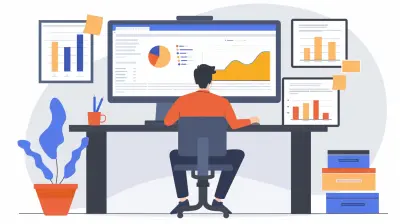Boosting Employee Efficiency in the Digital Age
31 May 2025
In today's fast-paced digital world, where every second counts, achieving and maintaining employee efficiency can feel like trying to catch a beam of light—it’s tricky but not impossible. Companies are more reliant than ever on digital tools, flexible work arrangements, and savvy strategies to help employees perform at their best. But, let’s be honest, technology can be either your best friend or your biggest headache.
So, how do you strike the perfect balance between leveraging tech and fostering human productivity? In this article, we'll dive into some practical strategies that businesses can adopt to ramp up employee efficiency in the digital age. Strap in because we’re about to unpack this topic in a way that’s simple, actionable, and straight to the point. 
Why Is Employee Efficiency So Important?
Imagine a ship where half the crew is slacking off, the other half is rowing in different directions, and there’s no captain steering the wheel. Sounds like a disaster, right? That’s what inefficiency looks like in a workplace.Employee efficiency isn’t just about getting things done; it’s about doing the right things in the most effective way possible. Efficient teams are productive, less stressed, and more motivated. Plus, when employees work smarter (not harder), businesses can save time, resources, and money.
In the digital age, where agility is key, efficiency is no longer a ‘nice-to-have.’ It’s the lifeline of any successful organization. 
The Challenges of Efficiency in the Digital Era
Before we jump into solutions, let’s address the elephant in the room: the digital age is a double-edged sword. While technology offers powerful tools to streamline workflows, it also introduces distractions and complexities.1. Information Overload
Ever feel like you're drowning in notifications, emails, or Slack messages? Employees spend a chunk of their day just sifting through information. The constant influx of data can overwhelm even the most organized individuals, leading to burnout and reduced focus.2. Digital Distractions
Social media, instant messaging platforms, and even gaming apps are just a click away. Let’s face it, resisting these temptations is easier said than done, especially when work gets monotonous.3. Tool Fatigue
Yes, there is such a thing as having too many tools. Switching between platforms for task management, communication, and file sharing can break the flow of work. It’s like trying to cook dinner while constantly searching for the right utensils.4. Remote Work Complexities
While remote work offers flexibility, it can also make collaboration trickier and blur the boundaries between professional and personal life. Without proper systems in place, employees might find themselves either overworking or underperforming.
Actionable Strategies to Boost Employee Efficiency
Okay, now onto the good stuff. How do we tackle these challenges and create a work environment that hums with productivity? Here are some proven strategies:1. Streamline Communication
Ever played a game of telephone as a kid? Miscommunication can lead to chaos, especially in the workplace. That’s why clear and concise communication is essential.- Use tools like Slack or Microsoft Teams for instant messaging, but encourage employees to use them mindfully (hello, “do not disturb” mode!).
- Have regular check-ins to ensure that everyone is on the same page. Weekly team meetings can work wonders for alignment.
> Pro Tip: Create communication guidelines to avoid unnecessary back-and-forths. For example, outline when it’s appropriate to send an email vs. a message on Slack.
2. Leverage Automation Tools
Why spend hours on repetitive tasks when robots can do them for you? Automation is the secret sauce to freeing up time for higher-value work.- Automate mundane tasks like data entry, performance tracking, or sending reminders. Tools like Zapier or Asana can bridge the gap between productivity and convenience.
- Use scheduling apps like Calendly to streamline meeting setups without the endless email ping-pong.
Automation doesn’t mean replacing human input; it means letting machines handle the grunt work so employees can focus on what really matters.
3. Provide Digital Training
Throwing employees into the digital deep end without any guidance is like handing someone a smartphone without explaining how to unlock it. Digital literacy is a must in today’s tech-driven environment.- Host regular training sessions to familiarize employees with new software, tools, and best practices.
- Create a knowledge base or FAQ repository to answer common tech-related questions.
> Investing in training isn’t just about efficiency—it’s also a morale booster. People feel more confident when they know their way around their tools.
4. Set Clear Goals and Expectations
Imagine trying to run a race without knowing where the finish line is. It’s frustrating, right? That’s exactly how employees feel when goals are ambiguous or constantly changing.- Use SMART goals (Specific, Measurable, Achievable, Relevant, Time-bound) to give employees a clear direction.
- Break big projects into smaller, manageable tasks to avoid overwhelm.
When employees know what’s expected of them, they can work with laser-sharp focus instead of shooting in the dark.
5. Encourage Breaks and Downtime
Sometimes, the best way to speed up is to slow down. Overworking employees can lead to fatigue, poor decision-making, and even burnout.- Encourage regular breaks using the Pomodoro Technique (25 minutes of work followed by a 5-minute break).
- Offer flexible work schedules to accommodate personal needs and preferences.
Taking a breather isn’t slacking off—it’s hitting the refresh button on your brain.
6. Foster a Culture of Feedback
Feedback is the fuel that powers improvement. Without it, employees might unknowingly fall into inefficient habits.- Schedule one-on-one reviews to provide constructive feedback and listen to employees' challenges.
- Use pulse surveys or anonymous feedback tools to gauge how employees feel about their workload and tools.
A culture of open communication builds trust and helps identify bottlenecks before they spiral out of control.
7. Optimize the Work Environment
Whether employees are in the office or working remotely, their environment plays a huge role in productivity.- For office spaces, invest in ergonomic furniture and quiet zones for focused work.
- For remote workers, provide stipends for home office upgrades like a good chair, desk, or noise-canceling headphones.
- Use proper lighting—natural light is an underrated productivity booster.
It's like this: you wouldn’t try to run a marathon in flip-flops. Why should employees work in subpar conditions? 
The Role of Leadership in Driving Efficiency
Let’s not forget the human element in all this. Leadership plays a central role in fostering employee efficiency. Leaders set the tone, create the processes, and provide the support employees need to thrive.- Lead by Example: Show your team how to prioritize tasks, manage time, and communicate effectively.
- Recognize Efforts: Celebrate wins, no matter how small. A little appreciation goes a long way in motivating teams.
- Be Adaptable: The digital age is ever-changing. Leaders should stay on top of trends and be ready to tweak strategies when needed.
Wrapping It All Up
Boosting employee efficiency in the digital age isn’t about working harder; it’s about working smarter. From leveraging automation tools to fostering a culture of clear communication and continuous feedback, the key is to create an environment where employees feel empowered, focused, and supported.Remember, efficiency isn’t a one-size-fits-all formula. What works for one team might not work for another. So, be flexible, test different strategies, and don’t be afraid to pivot when things don’t go as planned. After all, the digital world waits for no one—but with the right approach, you and your employees can stay ahead of the curve.
all images in this post were generated using AI tools
Category:
Workplace ProductivityAuthor:

Ian Stone
Discussion
rate this article
3 comments
Stella McQuillen
Great insights! In today's fast-paced digital world, empowering employees with the right tools and fostering a collaborative environment are key. Excited to see how these strategies can enhance productivity and drive business success! Keep up the great work!
June 13, 2025 at 11:11 AM

Ian Stone
Thank you! I appreciate your enthusiasm and support for these vital strategies!
Rory Cain
Boosting employee efficiency? Just remember: coffee breaks are essential. A well-caffeinated team is like a well-oiled machine—quirky, slightly unpredictable, but somehow getting things done with a smile!
June 5, 2025 at 10:40 AM

Ian Stone
Absolutely! Coffee breaks foster creativity and camaraderie, keeping teams energized and engaged. A balanced approach to work and play enhances overall efficiency.
Thalia McLaurin
This article offers valuable insights into enhancing employee efficiency in our fast-paced digital world. Embracing technology while fostering a supportive work culture can lead to remarkable productivity gains. Remember, small changes can make a big difference. Let’s empower our teams to thrive in this evolving landscape!
June 3, 2025 at 12:57 PM

Ian Stone
Thank you for your insightful comment! I completely agree that combining technology with a supportive culture is key to enhancing productivity. Small changes can indeed lead to significant improvements. Let’s continue to empower our teams together!



